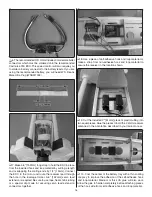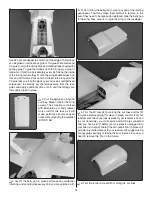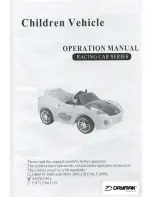
25
❏
2. Be certain the battery and receiver are securely mounted
in the fuse. Simply stuffi ng them into place with foam rubber
is not suffi cient.
❏
3. Extend your receiver antenna (if applicable) and make
sure it has a strain relief inside the fuselage to keep tension
off the solder joint inside the receiver.
❏
4. Balance your model
laterally
as explained in the
instructions.
❏
5. Use threadlocking compound to secure critical fasteners
such as the motor screws, screw-lock pushrod connectors, etc.
❏
6. Add a drop of oil to the axles so the wheels will turn freely.
❏
7. Make sure all hinges are
securely
glued in place.
❏
8. Reinforce holes for wood screws with thin CA where
appropriate (servo mounting screws, cowl mounting screws,
etc.).
❏
9. Confi rm that all controls operate in the correct direction
and the throws are set up according to the manual.
❏
10. Make sure there are silicone retainers on all the clevises
and that all servo arms are secured to the servos with the
screws included with your radio.
❏
11. Secure connections between servo wires and
Y-connectors or servo extensions, and the connection between
your battery pack and the on/off switch with vinyl tape, heat
shrink tubing or special clips suitable for that purpose.
❏
12. Make sure any servo extension cords you may have used
do not interfere with other systems (servo arms, pushrods, etc.).
❏
13. Balance your propeller (and spare propellers).
❏
14. Tighten the propeller nut and spinner.
❏
15. Place your name, address, AMA number and telephone
number on or inside your model.
❏
16. If you wish to photograph your model, do so before
your fi rst fl ight.
❏
17. Range check your radio when you get to the fl ying fi eld.
FLYING
The Proud Bird is a great-fl ying model that fl ies smoothly and
predictably. The Proud Bird does not, however, possess the
self-recovery characteristics of a primary R/C trainer and
should be fl own only by experienced R/C pilots.
CAUTION:
(THIS APPLIES TO ALL R/C AIRPLANES): If,
while fl ying, you notice an alarming or unusual sound such
as a low-pitched “buzz,” this may indicate control surface
fl utter.
Flutter occurs when a control surface (such as an
aileron or elevator) or a fl ying surface (such as a wing or
stab) rapidly vibrates up and down (thus causing the noise).
In extreme cases, if not detected immediately, fl utter can
actually cause the control surface to detach or the fl ying
surface to fail, thus causing loss of control followed by an
impending crash. The best thing to do when fl utter is detected
is to slow the model
immediately
by reducing power, then
land as soon as safely possible.
Identify which surface fl uttered (so the problem may be
resolved) by checking all the servo grommets for deterioration
or signs of vibration. Make certain all pushrod linkages are
secure and free of play. If it fl uttered once, under similar
circumstances it will probably fl utter again unless the problem
is fi xed. Some things which can cause fl utter are; Excessive
hinge gap; Not mounting control horns solidly; Poor fi t of
clevis pin in horn; Side-play of wire pushrods caused by
large bends; Excessive free play in servo gears; Insecure
servo mounting; and one of the most prevalent causes of
fl utter; Flying an over-powered model at excessive speeds.
Takeoff
Before you get ready to take off, see how the model handles
on the ground by doing a few practice runs at
low speeds
on
the runway. Hold “up” elevator to keep the tail wheel on the
ground. If necessary, adjust the tail wheel so the model will
roll straight down the runway. If you need to calm your nerves
before the maiden fl ight, bring the model back into the pits.
Top off the charge in your pack, then check all fasteners and
control linkages for peace of mind.
Remember to take off into the wind. When you’re ready, point
the model straight down the runway, hold a bit of up elevator
to keep the tail on the ground to maintain tail wheel steering,
then gradually advance the throttle. As the model gains
speed decrease up elevator allowing the tail to come off the
ground. One of the most important things to remember with
a tail dragger is to always be ready to apply
right
rudder to
counteract engine torque. Gain as much speed as your runway
and fl ying site will practically allow before gently applying up
elevator, lifting the model into the air. At this moment it is likely
that you will need to apply more right rudder to counteract
engine torque. Be smooth on the elevator stick, allowing the
model to establish a
gentle
climb to a safe altitude before
turning into the traffi c pattern.
Flight
For reassurance and to keep an eye on other traffi c, it is a
good idea to have an assistant on the fl ight line with you. Tell
him to remind you to throttle back once the plane gets to a
comfortable altitude. While full throttle is usually desirable for
takeoff, most models fl y more smoothly at reduced speeds.
Take it easy with the Proud Bird for the fi rst few fl ights, gradually
getting acquainted with it as you gain confi dence. Adjust the
trims to maintain straight and level fl ight. After fl ying around for
a while, and while still at a safe altitude with plenty of battery
charge, practice slow fl ight and execute practice landing
approaches by reducing the throttle to see how the model
handles at slower speeds. Add power to see how she climbs
as well. Continue to fl y around, executing various maneuvers
and making mental notes (or having your assistant write them
down) of what trim or C.G. changes may be required to fi ne
tune the model so it fl ies the way you like. Mind your battery
charge, but use this fi rst fl ight to become familiar with your
model before landing.




































